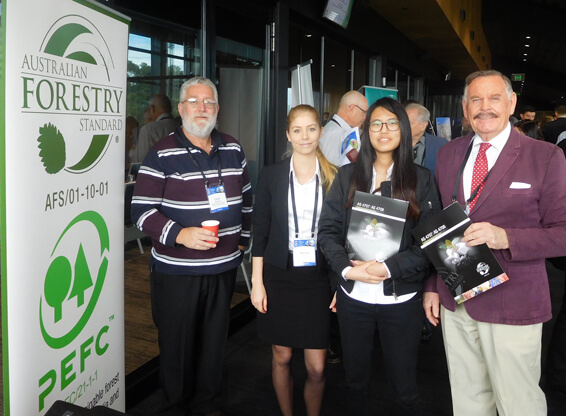
Jim Bowden, representing the Australian Forestry Standard (right) welcomes University of Queensland Masters students Melissa Ward (urban and regional development) and Ann Chiang (environmental management) with Frank Ondrus of Householders Options to Protect the Environment (HOPE), an Australian community-based non-profit environment organisation promoting sustainability at the householder level.
The forest industry – and its place in sustainable living – took a pivotal role at the 10th Making Cities Liveable Conference in Brisbane recently where the AFS exhibit explained the Australian Forest Certification Scheme, chain of custody systems and sustainable forest management practices to delegates.
Visitors to the stand represented a wide cross-section of government, academic and industry professionals who attended the two-day event to discuss sustainability, natural resource management, climate change, urban design and biosecurity.
Environmentally, a sustainable city is one that can keep going because it uses resources economically, avoids waste, recycles where possible and adopts policies that bear fruit in the long term.
“Forestry is the oldest and best example of sustainable planning,” Australian Forestry Standard CEO Simon Dorries said.
“I think what PEFC and AFS are contributing to sustainable living is really cool,” said Ann Chiang, a Masters student in environmental management at the University of Queensland, one of a group of students to visit the stand.
She said information on the stand had ‘opened her eyes’ to the value of certification and the chain of custody link between certified forests and the end products that consumers buy.
Mr Dorries said AFS was in discussion with university schools of environmental management and regional development about how lectures might expand the knowledge and value of forest certification among students.
More than 190 delegates, representing architecture, resource management, town planning, urban renewal (green buildings) and sustainable communities, attended the conference at the Hotel Grand Chancellor.
Opening speaker Dr Laurie Buys, Theme Leader of Queensland University of Technology’s (QUT) Institute for Future Environment’s (IFE) Infrastructure for Sustainable Communities Theme and Professor in the School of Design in the Creative Industries Faculty said the world’s population is growing, ageing and urbanising.
“Global demand for energy, water and resources is rising while finite natural resources are declining,” she said.
“Communities expect that public and private infrastructure – from energy and ICT networks to transport systems and buildings – will be integrated, sustainable and tailored to community needs.
“New ways of designing, building and managing infrastructure are emerging in the transition from the industrial to the digital age,” Dr. Buys said.
“The grand challenge for the world is creating infrastructure that enriches communities while being sustainable, resilient and responsive to climate change.”
Ssustainable cities will help realise this goal.
“And sustainable cities need wood and forest products sourced from responsibly managed forests” Simon Dorries said.
“With over 24 million hectares of managed forests certified under the AFS scheme, Australia certainly has the resources at hand to help achieve this transition.’







